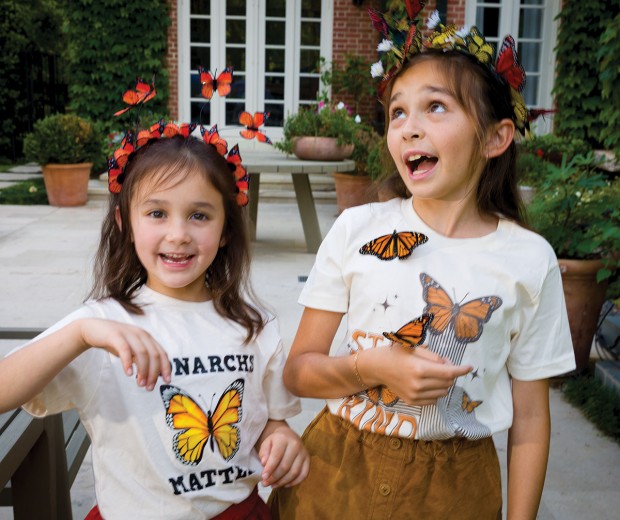Caterpillars to Companions
How monarch butterflies turned neighbors into family

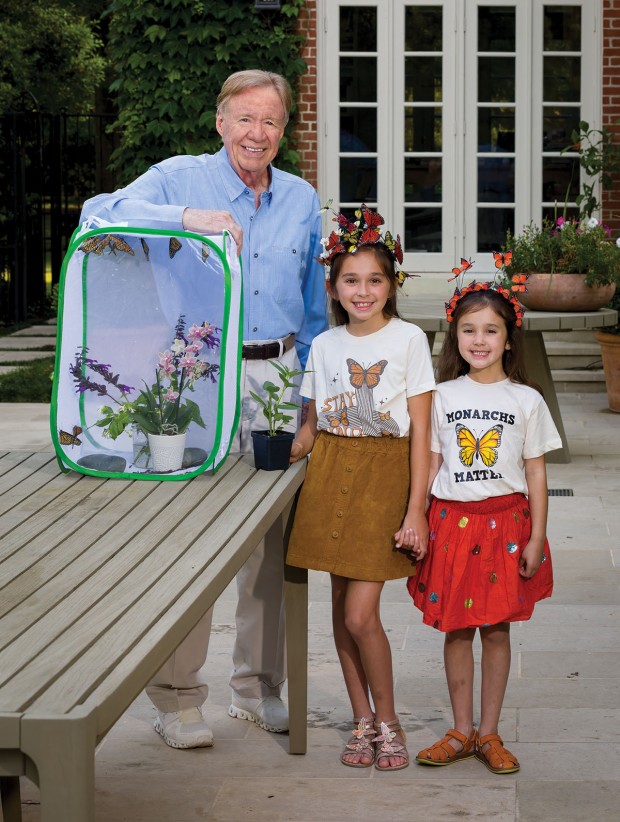
ALL AFLUTTER Raising monarch butterflies is a passion for Joe Cialone and his neighbors, sisters Ceci,10, (middle) and Emie Van Syoc, 7, who prepare here for a release. What started as a mutual interest has bonded them like family. (Photo: hartphoto.com)
Friendships are rarely born with fanfare. They begin in the simplest, most serendipitous ways. Through volunteer shifts and book clubs. Over heartbreak, and unexpected kindnesses. They start in waiting rooms, on park benches, over the love of music.
And sometimes bonds are solidified over something so delicate and fleeting as the endangered monarch butterfly. Over a combined passion for raising them till they flutter north on paper-thin wings.
“They’re the most beautiful little things and it feels good to help them along the way,” says Laura Van Syoc of the passion project she started with daughters, Ceci, now 10, and Emie, 7, in 2020, during the Covid pandemic. When the world turned in on itself and school vanished into screens, paper, scissors, and a myriad of craft projects weren’t cutting it.
But raising the tiny travelers – the only butterfly in existence that makes a two-way, long-distance migration – gave new rhythm to life. A miracle on wings.
Unbeknownst to them, just a block away, Joe Cialone, 81, was just as hooked. His passion for monarchs started decades ago, when his two sons, long since grown, raised monarchs as a school project. Long after the days of report cards, Joe still tends to milkweed – the monarch’s life sustenance – with the precision of a farmer, in his backyard.
He diligently checks leaves for eggs, and watches tiny, striped caterpillars chomp their way into fatness.
His voice picks up pace when he talks of their metamorphosis. He describes the process with awe and reverence, as if depicting something sacred: How caterpillars spin a tiny button of silk, anchoring themselves upside down in a perfect J shape. How, when it sheds its skin for the final time, its soft chrysalis (the pupa stage in the lifecycle) hardens, becoming a beautiful jade green, adorned with golden accents. How, just before the butterfly emerges, its black and orange wings can be seen through a darkened, translucent chrysalis, revealing the glory inside.
When monarchs emerge, they don’t dawdle, Joe explains. They lift into the sky, heading north. Without fail. It’s the start to their two-way long-distance migration, fluttering across thousands of miles of fields, cities, mountains, and rivers. “No other butterfly does this,” he says.

BUTTERFLY BEAUTIES It’s all things monarch butterfly for sisters, (from left) Emie and Ceci, who love to wear them and hold them before they take off north in flight. (Photo: hartphoto.com)
Spring and summer generations surge northward in waves, each generation born further up the journey, pushing the species closer to Canada. When autumn comes, the monarch knows to fly south, to the mountains of central Mexico where they overwinter, clinging in clusters to trees, a pulsating blanket of orange and black. When spring stirs, they begin the first leg of their journey north again.
“There are so many things that can get in the way of an egg ever actually growing up to become a monarch,” says Laura.
Monarchs follow the seasons like clockwork, their migration timed to temperature, wind, and bloom. Late springs, early freezes, and more frequent violent storms don’t sync with the choreography they’ve followed for generations, say ecologists. Too much rain can drown caterpillars. Too much heat can dry out milkweed before it’s useful.
And the milkweed they rely upon used to grow everywhere, wild along roadsides, in pastures. But neat rows of monoculture have replaced the plant and herbicides have killed it.
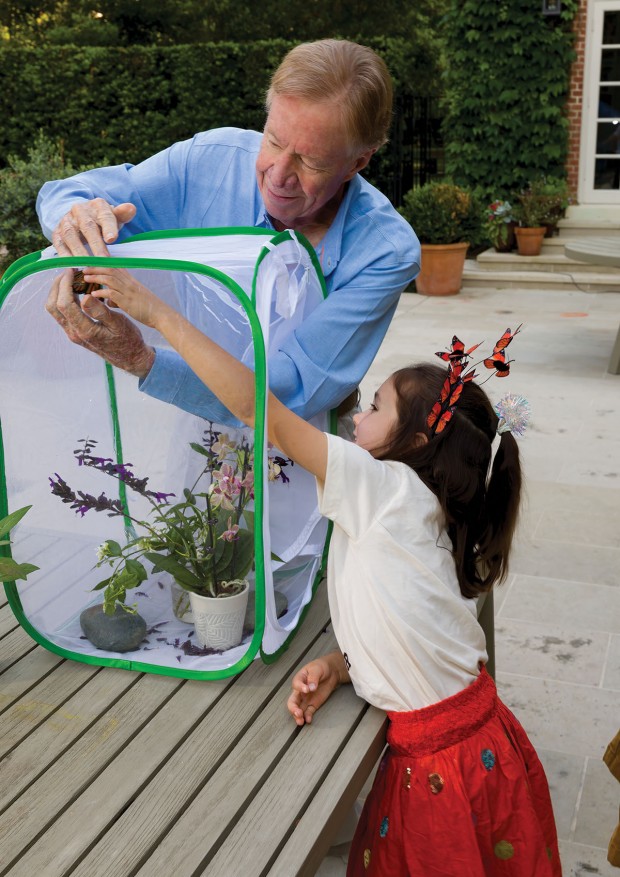
Joe handles a monarch, while Emie looks on, as it prepares for its first flight. (Photo: hartphoto.com)
What’s more, their sacred wintering grounds high in the fir forests of central Mexico are disappearing, trees cut down for lumber, and dying slowly from warmer temperatures and bark beetle infestations, say experts who monitor monarch populations.
“It feels good to raise monarchs in our own little way, to see them take flight,” says Laura. Laura is happy for neighbor Joe’s expertise.
“A neighbor mentioned to me that we should meet Joe because he was raising monarchs, too. So, one day, we were on a walk in front of his house, and we stopped and talked,” Laura recalls. “And boy, have we learned a lot from him!”
“He taught us all about how they fly all the way to Mexico!” says Ceci, who with sister Emie, students at River Oaks Baptist School, make up a collective of youthful, strong eyes. They help their mom and Joe spot eggs, no bigger than the tip of a pencil, on the milkweed plants.
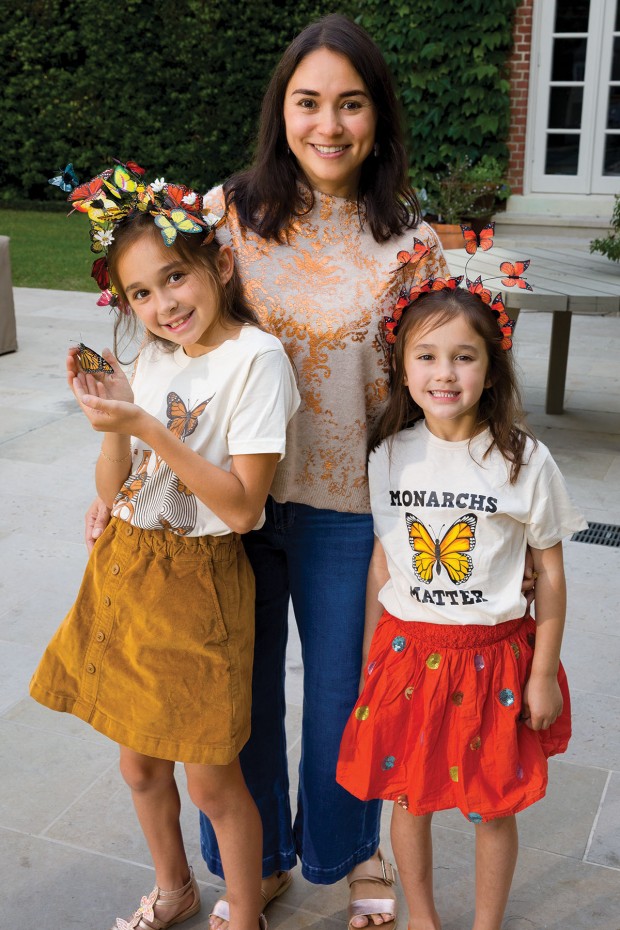
PASSION PROJECT Laura Van Syoc, flanked by daughters Ceci, left, and Emie, right, started raising monarchs during the Covid pandemic, a fun alternative to traditional paper and scissor crafts and other activities. (Photo: hartphoto.com)
“When Joe and I think we’ve found all the eggs on a milkweed plant, and all the caterpillars, my girls can find 30 more!” Laura says.
Aphids are the milkweed’s nemesis. Garden pirates that plunder, sipping relentlessly into the plant’s soft tissue, caring nothing about the monarch eggs laid delicately on its leaves, or for baby caterpillars nibbling away. Laura taught Ceci and Emie to brush away the aphids with a paintbrush, stopping the tiny tyrants.
“I’m telling you, those little girls are becoming expert monarch caretakers,” exudes Joe, a former attorney, who with wife, Brenda, a retired chief operating officer over an attorney group, loves their visits. “They’re like grandparents,” says Emie. “And they give us Blue Bell ice cream!”
The sisters bring them gifts, like a butterfly crafted of Perler beads that sits on the couple’s kitchen counter.
Sometimes, nature’s guardians must help nature, stresses Joe. “Sometimes the chrysalis isn’t hanging correctly on the milkweed for whatever reason. They’re in a precarious position or the silk fails.”
Kind of like a bungee jumper with an untrustworthy cord.
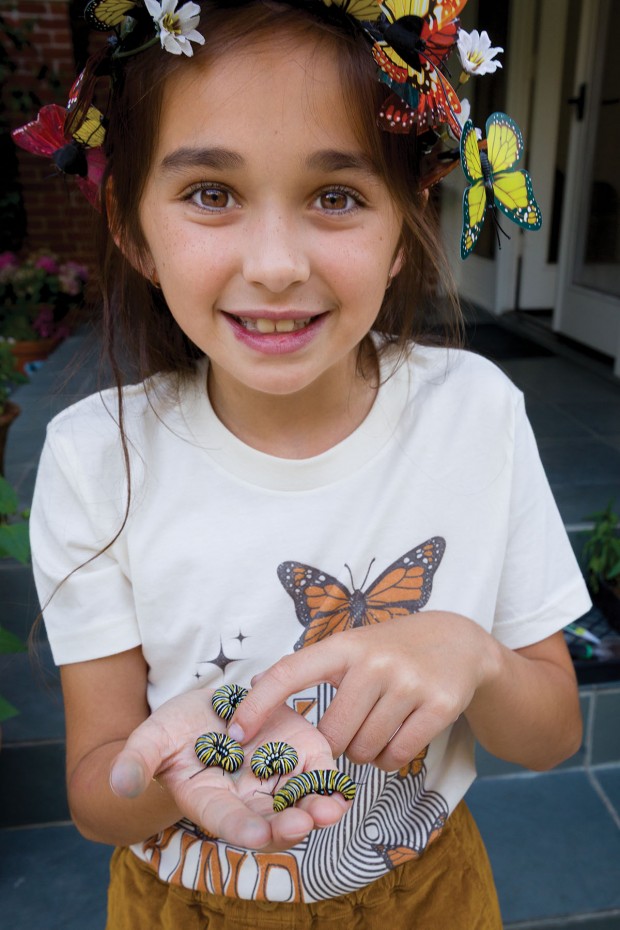
Ceci palms a handful of fat caterpillars, inching their way into becoming butterflies. (Photo: hartphoto.com)
So, Joe brings the chrysalis into the kitchen, sometimes using dental floss for an alternative hanging thread, taping the jade-colored marvels to the underside of cabinets.
They dangle like tiny lanterns, secure and safe from predators.
“The girls came over one day and saw a full-fledged butterfly in the kitchen,” says Laura, laughing. “Yeah, that one got by me,” says Joe who didn’t quite get the monarch memo: I’ve arrived!
Joe’s wife is a good sport, he says. Though she doesn’t like handling the butterflies.
“Although I’ve been forced to do so,” quips Brenda. And what does she think of all this? “I’m glad he has a hobby he enjoys that keeps him home a fair bit. And it really is a beautiful thing. Our favorite thing is having these precious little girls over.”
“We miss them terribly when they’re out of town,” says Joe of Ceci and Emie, who look forward to teaching a new family member about monarchs. Laura and husband Rhett, a mergers and acquisitions attorney, are expecting a baby boy soon.
Joe’s love of all things nature began in childhood. The books in his den are telling. In one stack: The Nature of Oaks. Night Herons. Backyard Bird Book. What It’s Like to Be a Bird.
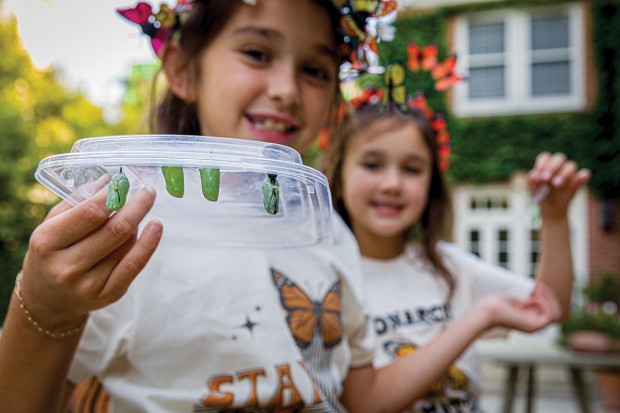
Ceci holds a container with several dangling chrysalis – the pupa stage of the butterfly that becomes a beautiful jade green – as Emie looks on. (Photo: hartphoto.com)
He grew up on a farm in Arkansas. Not a working farm, no cash crops or cattle to tend. But land just the same, his chunk of paradise, where he’d frolic in the creek, lifting rocks to find crawdads. “I mean, I’m just a critter person. I love snakes. I really do,” he says. “But my favorite animal is a turtle.”
His dad was manager of a milk producers association in northwest Arkansas, and he drove around the state visiting dairy farms. “I would drive around with him sometimes and if there was a turtle in the road, we’d put it in a box, and it went home with us.”
To Joe, nature and critters are the rhythm of life, a grounding he’s always embraced.
But he’s not so fond of wasps. This day, he points to a butterfly net that he doesn’t use for butterflies. He uses it to capture their nemesis, who is on the hunt for caterpillars. Wasps are methodical in their savagery, tearing the hapless caterpillar in half at times.
“So, I keep eyes sharp, always looking for wasps,” Joe says. “Those things hover like helicopters, up, down, and around, in search of caterpillars. That poor little caterpillar is vulnerable to anything. I read that about five percent of eggs laid will make it into a butterfly. And a female can lay hundreds of eggs.”
“And I’ve read that monarchs can sense milkweed from a long way away,” joins in Laura with another factoid. “They can find the tiniest of little milkweed plants. I’m glad I’m at the point now that I have a pretty good amount of milkweed and don’t have to always go hunting at nurseries. I need my milkweed!”
She’s learned the hard way the proper way to handle milkweed.
While it’s food to the monarch butterfly – a lifeline for the species’ survival – a toxic white milky sap is inside its leaves and stem. They store it like a warning, most would-be predators staying clear of its bitter taste.
To humans, the sap is no joke. If you rub your eyes after handling milkweed, it can cause intense irritation, swelling, blurred vision and, at times, even temporary blindness.
“Anytime you touch it, you must wash your hands. My girls know this. They saw what happened to me,” she says. “I woke up seeing white spots and halos all over and I was like ‘What is going on?’”
“I was like, ‘What’s happening?’ Emie shrieks. “It was not good!”
Laura made an emergency trip to the eye doctor.
Have you ever touched milkweed?
“I told the doctor ‘I literally was just handling milkweed before coming to you.’ He explained that the toxin in milkweed blocks something in your eyes that’s in charge of draining excess liquid out of your retina. So, I basically had an excess accumulation of fluid in my eye.”
Steroid drops cleared it up. “I probably hadn’t washed my hands yet and put my contacts in,” she says. “My girls and I never take any chances now!”
Check the history books for other amazing things about milkweed, encourages Joe. The lowly milkweed answered a call in World War II that no one expected. America’s scrappiness turned to the plant to provide a buoyancy for life preservers.
Milkweed floss, the silken threads inside its green, horn-shaped pods, aren’t just soft. They’re hollow. Each filament carries air inside it, giving it a natural buoyancy. It was packed into soldiers’ and sailors’ life jackets. By war’s end, millions of pounds of milkweed floss had been collected, enough to fill hundreds of thousands of life vests, turning the plant into battlefield lifelines.
“It’s almost magical. The story of milkweed and the story of the monarch,” Joe says.
“Releasing them is fun!” says Ceci. “And we can tell the females from the males,” chimes in Emie.
To tell male from female monarch butterflies, you focus on the hind wings, they instruct. Males have two small black spots on the hind wings that the females lack.
Her daughters were tempted to name each butterfly at the beginning of their monarch mission, says Laura, with a chuckle. “But that wasn’t happening. No way to tell them apart and too many!”
Butterflies, by nature, are fleeting. Lives measured in weeks. But raising butterflies together leaves behind something permanent, says Laura. Joe agrees.
“We’re like family with Joe and Brenda. It started with butterflies, but it’s so much more.”
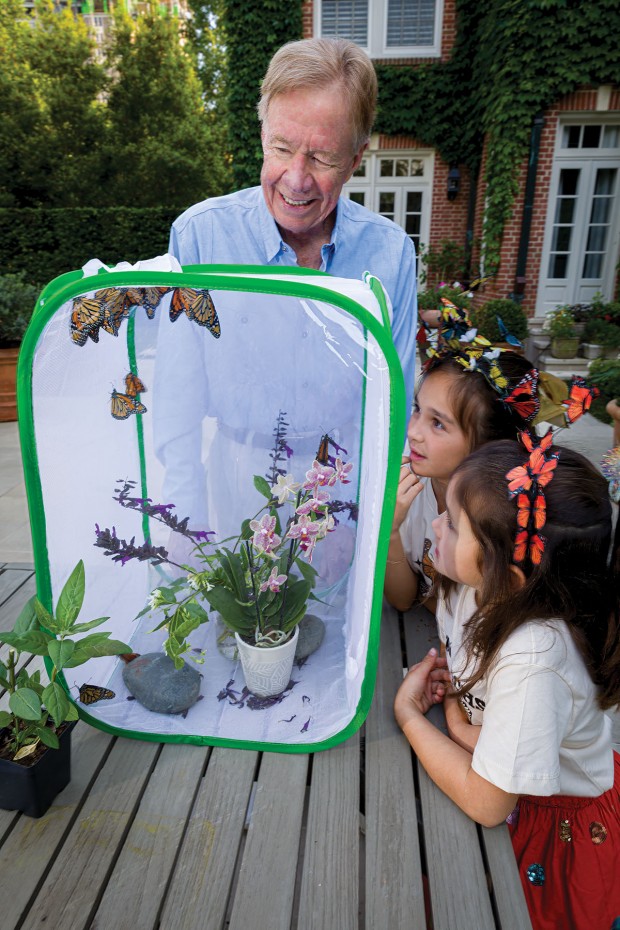
MONARCH MISSION Joe Cialone and neighbors, sisters Ceci Van Syoc, 10, (middle) and sister Emie, 7, prepare to release monarch butterflies. The neighbors have bonded over their love of monarchs, a creature they raise from egg to full-fledged orange and black creatures, ready for flight. (Photo: hartphoto.com)
Monitoring Monarchs
Monarch Watch, a volunteer-based citizen science organization that tracks the fall migration of the monarch butterfly, offers nonprofit education, conservation, and research programs at the University of Kansas that focus on the butterfly’s habitat and ways to help the endangered species.
The group works to promote monarch conservation through initiatives such as the Monarch Watch Waystation Program that involves monarch tagging to help understand their migration patterns, timing, and the impact of environmental factors, data that’s crucial to responding to habitat loss, climate change, and other factors affecting the population.
“Where should we start? Everything about the monarch is so incredible,” says Nancy Greig, who was director of the Cockrell Butterfly Center at the Houston Museum of Natural Science for 24 years, since its inception. While the center has resources about the monarch, it only displays exotic tropical species not found in the United States.
“Monarch Watch is an excellent resource for people wanting to learn more about the monarch butterflies,” says Greig, who recently attended a Monarch Watch conference. She recommends the 2012 film Flight of the Butterflies that highlights the monarch butterfly’s journey, migrating thousands of miles from Canada and the United States to specific overwintering sites in the mountains of central Mexico.
The movie focuses on Dr. Fred Urquhart, a Canadian entomologist, and his wife, Norah, who dedicated their lives to understanding the monarch’s migration. And it showcases the role of citizen scientists, including a couple in Mexico, who helped the Urquharts locate the overwintering sites, a breakthrough in understanding the monarch’s life cycle.
Urquhart pioneered the tagging program which later evolved into the Monarch Watch program.
“Why do they go to the same place every year? It’s an incredible phenomenon,” says Greig. “The Monarch Watch is a great way to learn more and get involved. Monarchs really capture people’s imaginations.”
Visit www.monarchwatch.org for more information.
Want more buzz like this? Sign up for our Morning Buzz emails.
To leave a comment, please log in or create an account with The Buzz Magazines, Disqus, Facebook, or Twitter. Or you may post as a guest.


